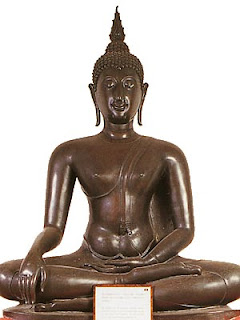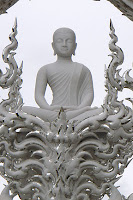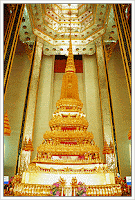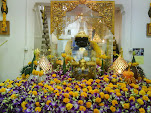
- 好像坤平将军 - 人缘方面特别灵验
- 招财女神 - 利财运
- 拍洛佛牌,助运程,避官非等等,
因此如是有所求,便应以你所求的方向,来选择佛牌。
Whatever that is written here is not intended to harm or hurt anybody.Either ways, I bear no responsibilities for any physical or emotional harm to anybody or organisation.


因此如是有所求,便应以你所求的方向,来选择佛牌。
其实对一位尊重佛法僧的人来说,佩带佛牌并没有什么特别的禁忌,因为这些禁忌对尊重佛法僧的人来说都不会触犯,而佩带佛牌需要遵守的禁忌有以下几点:
只要紧记以上三点经已十分足够。如因一时忘记触犯佩带佛牌禁忌(注意是一时忘记不是明知故犯),你只要诚心向佛牌忏悔,下次不再触犯同样错误,有机会将佛牌给僧人或一些师父再加持便可,但如你是明知故犯,我想你也不太适合佩带佛牌了喔。
胡
胡
Times of luxury do not last long, but pass away very quickly; nothing in this world can be long enjoyed.
I'm really sicked of repeating to myself - Tomorrow will be better! but what can I do except this..... oh ya, Pray... Pray hard.. Pray harder...
胡
如要说大师的神奇事迹,便必要讲以下两宗,第一是令到英文报章也报导的事,第二宗是发生在大师圆寂后的。
先讲第一宗,话说一日泰国军用飞机飞至泰国清迈府之上,机上载著七位医生,突然其中一位医生看到在一片云上,有一僧人坐在云上禅定,其后更慢慢下降回地面,机上的人看到都说是自己眼花,但问题是所有的人都看到了,哪会同一时间各人都眼花呢?于是便查看地图位置,发现是在屈内咩宾佛寺附近,之后其中一位医生便到屈内咩宾佛寺附近查看,到屈内咩宾佛寺附近便向村人查问附近有否得道高僧,村人分分说在屈内咩宾佛寺,住有一位龙甫湾大师是得道高僧,这位医生便到屈内咩宾佛寺拜访,当看见龙泡湾大师,立即赫了一跳,因大师的容貌与医生在飞机上看到的高僧容貌一模一样,医生便问大师是否当日在云上禅定,大师只是笑说一句,"你当我是鸟吗?",其后一英文报章也有报导这事迹。
第二宗事迹发生在大师圆寂后进行火化时,大师的火化法事,泰国国王及很多高官也有参加,善信人数不用说,也知道众多,就火化法事应没有什么特别,但在火化塔进行火化时,火化塔冒出烟火,这时奇怪的事发生,在火化塔旁特然出现一个发光人影,很多人都能看到,各人称奇。
胡
Locals from Bang Phli in Samut Prakan pay respect to the revered Buddha image, Luang Pho To, by throwing lotus flowers.
This literally means to throw lotus flowers which is exactly what happens. The people of Bang Phli, and from far around, come to the temple at Wat Bang Phli Yai Nai to pay respect to the revered Buddha image called Luang Poh To. A replica of this sacred image is put on a boat which then goes up and down the canal in order for people to pay respect. They do this by throwing lotus flowers onto the boat. There are always thousands of people attending and it is complete chaos. Certainly worth attending if you are in this area at the end of the Buddhist Lent next year
Bang Phli is a district with an abundance of lotuses. The morning of the 14th full-moon night of October is the day before the end of the Buddhist Lent. Buddhists come here to pick the flowers for offerings to monks according to tradition. The people of Bang Phli regard this as great merit so they volunteer to keep the flowers for distribution to visitors who row to the district to receive them every year. This is to provide facilitation and is a way to jointly make merit. This tradition has become the "Rap Bua" (lotus receiving) festival.
These lotus flowers are meant as homage to the Triple Gem -- the Lord Buddha, Dhamma and the Sangka. Besides, the Bang Pli local People will also throw lotus flower onto visitors’ boats as a gesture to invite them join in their merit-making.
胡
 Yantra, or Tattoos, used in Cambodia and Thailand, are believed to have magical powers. There are legends of some old people in Cambodia today who believe they will NEVER die because they have a tattoo which grants them eternal life.
Yantra, or Tattoos, used in Cambodia and Thailand, are believed to have magical powers. There are legends of some old people in Cambodia today who believe they will NEVER die because they have a tattoo which grants them eternal life.
 著名高僧銮达波昨天向中央银行捐献48条黄金锭,总重600公斤,价值5亿1200万铢。移交仪式在曼谷佛教城三路的「萱盛探」(佛光园)修行场所隆重举行。 这是銮达波高僧自1997年发生金融危机以来,第14次向中央银行捐献黄金锭。据统计,14次捐献的黄金锭总共有931条,总重1万1630公斤,还不包括1080万4489美元现金。这些黄金和美元是由这位高僧在全国的善信捐给的,銮达波高僧强调,捐给中央银行的黄金和美元,必须用作国库储备黄金和外汇存底,以提高国家金融和经济稳定,化解金融危机。 在朱拉蓬公主的赐主持和见证下,銮达波高僧昨天下午把这批黄金锭移交给中央银行行长她丽莎女士,移交仪式在曼谷佛教城三路的「萱盛探」(佛光园)修行场所隆重举行。
著名高僧銮达波昨天向中央银行捐献48条黄金锭,总重600公斤,价值5亿1200万铢。移交仪式在曼谷佛教城三路的「萱盛探」(佛光园)修行场所隆重举行。 这是銮达波高僧自1997年发生金融危机以来,第14次向中央银行捐献黄金锭。据统计,14次捐献的黄金锭总共有931条,总重1万1630公斤,还不包括1080万4489美元现金。这些黄金和美元是由这位高僧在全国的善信捐给的,銮达波高僧强调,捐给中央银行的黄金和美元,必须用作国库储备黄金和外汇存底,以提高国家金融和经济稳定,化解金融危机。 在朱拉蓬公主的赐主持和见证下,銮达波高僧昨天下午把这批黄金锭移交给中央银行行长她丽莎女士,移交仪式在曼谷佛教城三路的「萱盛探」(佛光园)修行场所隆重举行。
胡

人生最大的失败是自大
人生最大的罪过是杀生
人生最大的愚蠢是欺骗
人生最可恶的是淫乱
人生最可怜的是嫉妒
人生最痛苦的是痴迷
人生最羞辱的是献媚
人生最危险境地是贪婪
人生最烦恼的是争名利
人生最善良行为是奉献
人生最大的债务是受恩
人生最大的欣慰是布施
人生最大的财富是健康
人生最大的破产是绝望
人生最可佩服是精进
人生最缺欠的是智慧
 Luang Pu Waen BE2431 - 02.07.BE2528
Luang Pu Waen BE2431 - 02.07.BE2528The Tai Sui 太岁 are stars directly opposite of Jupiter. They influence the Chinese zodiac, and are also a theory in Taoism and Feng Shui.
In the Chinese zodiac, there are sixty heavenly generals who assist the Jade Emperor in taking charge of the well-being of the Mortal World. Each of them takes turn to be in charge for a year. Due to most of them having a military background, they are normally known as the Military Generals, or as the Cycle Gods. Each of their features and weapons signifies the well-being of that year. For example, if the Tai Sui of the year is one who holds a pen, it signifies political unrest for that particular year. On the other hand, if the Tai Sui of the year holds a spear or sword it signifies the need to work hard and excel for that year.
In Taoism, those who offended, or by their sign conflict with the Tai Sui of the year are advised to go through a prayer session with a Taoist Priest to ask for blessing in obtaining Peace and Good Fortune throughout the year. Talismans thought to protect again Tai Sui are sold in many areas.
 太岁是掌管一年凡间事务的天神,由六十位天界大将军轮流值年,即中国的六十花甲。要知太岁的来历典故必须从太岁的上司斗姆元君说来了。斗即北斗星群,姆即众生得圣子,补裨造化,统绐乾坤。一年春天,紫光夫人在后园九华曲池沐浴,忽然池中现出一宝座,紫光夫人登于宝座之上,得宝座灵气修练得道,经七日七夜,紫光夫人化生金莲九苞,莲苞开花放射光芒,化成九座大宝楼阁,大宝楼阁混凝直射上天界,形成众星群即斗姆生九子。斗姆九子即勾陈、北极、北斗中国三大星座,当中有六颗星即为六十大将军掌管人间每年事务,即为六十太岁了。
太岁是掌管一年凡间事务的天神,由六十位天界大将军轮流值年,即中国的六十花甲。要知太岁的来历典故必须从太岁的上司斗姆元君说来了。斗即北斗星群,姆即众生得圣子,补裨造化,统绐乾坤。一年春天,紫光夫人在后园九华曲池沐浴,忽然池中现出一宝座,紫光夫人登于宝座之上,得宝座灵气修练得道,经七日七夜,紫光夫人化生金莲九苞,莲苞开花放射光芒,化成九座大宝楼阁,大宝楼阁混凝直射上天界,形成众星群即斗姆生九子。斗姆九子即勾陈、北极、北斗中国三大星座,当中有六颗星即为六十大将军掌管人间每年事务,即为六十太岁了。 The Phra Singh Buddha has been a significant Buddha image of the Thai lanna people for many years. However there is uncertainty as to how the image came to Lanna. A copy of the Pala school image in high relief may have been brought back to Chiang Mai in 1455, along with the plans of the Mahabodhi temple, which formed the basis for Wat Jet Yod. The Lanna sculptors who were of the Sukhothai school would then have made copies as bronze images in the round. Thus the "lion" style images of Lanna combine the flowing grace and posture of the Sukhothai school with features of the Pala school of India.
The Phra Singh Buddha has been a significant Buddha image of the Thai lanna people for many years. However there is uncertainty as to how the image came to Lanna. A copy of the Pala school image in high relief may have been brought back to Chiang Mai in 1455, along with the plans of the Mahabodhi temple, which formed the basis for Wat Jet Yod. The Lanna sculptors who were of the Sukhothai school would then have made copies as bronze images in the round. Thus the "lion" style images of Lanna combine the flowing grace and posture of the Sukhothai school with features of the Pala school of India.
Wat Sothornwararamworaviharn or Wat Hong is the oldest temple in Chachoengsao Province.
The temple is located within the town Chachoengsao on the banks of the Bang Pakong River'
According to the legend, this Buddha image had been floated along the river, before being placed here at this temple. The original image was a beautiful Buddha image, but later on cement was placed on the image to prevent from burglary. Worshippers from all walks of life come to pay respect to this most reputed image by pasting gold leaves on the image.
Many Thais pay respect to Phra Phutthasothon which is one of the moset revered in the country. There is a legend that Phra Phutthasothon is one of the three brothers that fled from the ravages of war during the Ayutthaya period. They just got up one day and jumped into the river. One of them ended up at Samut Songkram. Another ended up in Samut Prakan. The third arrived in Chachoengsao. In each case, the Buddha images only came to shore when the local villagers paid proper respect. Efforts to retrieve it were unsuccessful until a villager had a small shrine erected on the site and performed a ceremony welcoming the image to the community.

There are a total of 3 celebration in a year -
 Wat Pa Lelai stands just south of Wat Chimphli on Koh Kret. It is now a deserted monastery and te only remaining structure is an Ayutthaya-style congregation hall. In front of the hall a Buddha image with a monkey and an elephant represents the generally entitled Phra Phuttha Palelai image ( Rahu). This episode in Buddha gestures means that His needs were taken care of even by the members of the animal kingdom.
Wat Pa Lelai stands just south of Wat Chimphli on Koh Kret. It is now a deserted monastery and te only remaining structure is an Ayutthaya-style congregation hall. In front of the hall a Buddha image with a monkey and an elephant represents the generally entitled Phra Phuttha Palelai image ( Rahu). This episode in Buddha gestures means that His needs were taken care of even by the members of the animal kingdom. The current era, which is known as the Rattanakosin period began when King Rama I established Bangkok as the capital of Thailand in the 10th century. The period can be categorized into 2 distinct phases.
The current era, which is known as the Rattanakosin period began when King Rama I established Bangkok as the capital of Thailand in the 10th century. The period can be categorized into 2 distinct phases.
胡
 The Ayutthaya period began when King Ramathibodi I ( King U thong ) established Ayutthaya as a capital city in the 10th century A.D at the hands of the Burmese.
The Ayutthaya period began when King Ramathibodi I ( King U thong ) established Ayutthaya as a capital city in the 10th century A.D at the hands of the Burmese.胡
 The art of U Thong originated in the Central region of Thailand between the 12th and 15th Centuries A.D. The style was developed was influences from different areas. U Thong Art falls into 3 distinct types.
The art of U Thong originated in the Central region of Thailand between the 12th and 15th Centuries A.D. The style was developed was influences from different areas. U Thong Art falls into 3 distinct types.
胡
 In the 14th century A.D, King Sri Indrathit declared Sukhothai’s liberation from the Khmer and adopted a form of Buddhism based on the Sri lanka School. During this time, Sukhothai Art developed a radically different appearance to Mon and Khmer styles.
In the 14th century A.D, King Sri Indrathit declared Sukhothai’s liberation from the Khmer and adopted a form of Buddhism based on the Sri lanka School. During this time, Sukhothai Art developed a radically different appearance to Mon and Khmer styles.胡
 Chiang Saen-Lanna Art refers to object found in Northern Thailand dating between 11th, 13th or 10 centuries AD. The Buddha images from this period can be categorized into 2 distinct phrases.
Chiang Saen-Lanna Art refers to object found in Northern Thailand dating between 11th, 13th or 10 centuries AD. The Buddha images from this period can be categorized into 2 distinct phrases.It was during this time that the creation of Buddha images in crystal and precious stone became very popular.
胡
 Lopburi art is widely found in the central, east and the Northeast of Thailand. It can be dated around 11th to 13th centuries AD.
Lopburi art is widely found in the central, east and the Northeast of Thailand. It can be dated around 11th to 13th centuries AD. The Srivijaya Kingdom is believed to have thrived in Sumatra between the 8th and 13th centuries A.D. At this time, Srivijaya art was influenced not just by the indian art forms through trade but also Dvaravati,javanese and khmer art. Buddha images from this period are mostly related to Mahayana Buddhism; however, religious object including those of Theravada Buddhism and Hinduism have also been discovered.
The Srivijaya Kingdom is believed to have thrived in Sumatra between the 8th and 13th centuries A.D. At this time, Srivijaya art was influenced not just by the indian art forms through trade but also Dvaravati,javanese and khmer art. Buddha images from this period are mostly related to Mahayana Buddhism; however, religious object including those of Theravada Buddhism and Hinduism have also been discovered. Dvaravati ( land of Buddhism) refers to the kingdom situated in the Chao Phraua river basin between the 7th and 11th centuries AD. Important archaeological objects of Dvaravati art comprise Buddhism related sculptures representing 2 distinct sect known as Theravada and Mahayana.Dvaravati Art can be sub categorized into 3 groups according to the craftmanship.
Dvaravati ( land of Buddhism) refers to the kingdom situated in the Chao Phraua river basin between the 7th and 11th centuries AD. Important archaeological objects of Dvaravati art comprise Buddhism related sculptures representing 2 distinct sect known as Theravada and Mahayana.Dvaravati Art can be sub categorized into 3 groups according to the craftmanship.
胡



 Good men and bad men differ radically.
Good men and bad men differ radically.
 Throughout the past two centuries, the temple has been renovated and elevated in status by many Thai kings and royalties. It became the Wat Mahathat of Bangkok in 1803 and was given its current name in 1996.
Throughout the past two centuries, the temple has been renovated and elevated in status by many Thai kings and royalties. It became the Wat Mahathat of Bangkok in 1803 and was given its current name in 1996.Eitipiso Taywana Sukato Sawaha Sewahong
依第必苏 铁哇呐 苏加都 沙哇哈 沙哇鸿
***Chant each side once. 每一面念一次
胡
胡

 Wat Srisa Thong is most popular with Rahu followers because it has a giant statue of Rahu, the biggest in Thailand. Some Thai people believe that bad luck always comes with an eclipse, so major changes and big losses are inevitable. Visits to Wat Srisa Thong then become more popular before such event. The temple is located at Nakhon Pathom, 50 kilometers (30 miles) west of Bangkok.
Wat Srisa Thong is most popular with Rahu followers because it has a giant statue of Rahu, the biggest in Thailand. Some Thai people believe that bad luck always comes with an eclipse, so major changes and big losses are inevitable. Visits to Wat Srisa Thong then become more popular before such event. The temple is located at Nakhon Pathom, 50 kilometers (30 miles) west of Bangkok.